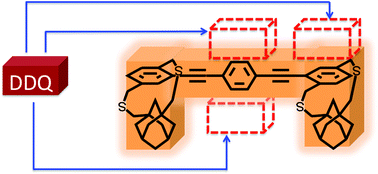Molecular tetrominoes: selective masking of the donor π-face to control the configuration of donor–acceptor complexes†
Abstract
Understanding the doping mechanism in organic semiconductors and generating molecular design rules to control the doping process are crucial for improving the performance of organic electronics. Even though controlling the location and orientation of the dopant along the semiconductor backbone is an important step in the doping mechanism, studies in this direction are scarce as it is a challenging task. To address this, herein, we incorporated π-face masked (strapped) units in 1,4-bis(phenylethynylene)benzene (donor) to control the acceptor (dopant) location along the trimer, donor–acceptor binding strength, and acceptor ionization. Two strapped trimers, PCP and CPC, are synthesized with control over the location of the strapped repeat unit in the trimer. The trimers are complexed with the 2,3-dichloro-5,6-dicyano-1,4-benzoquinone (DDQ) acceptor in solution. DFT calculations show that DDQ residing on the non-strapped repeat unit (the percentage of this configuration is at least ca. 73%) has the highest binding energy for both PCP and CPC. The percentage of dopant ionization is higher in the case of strapped trimers (PCP and CPC) compared to that of linear control trimers (PLP and LPL) and the completely non-strapped (PPP) trimer. The percentage of dopant ionization increased by 15 and 59% in the case of PCP and CPC respectively compared to that of PPP.

- This article is part of the themed collection: Supramolecular chemistry in OBC


 Please wait while we load your content...
Please wait while we load your content...
